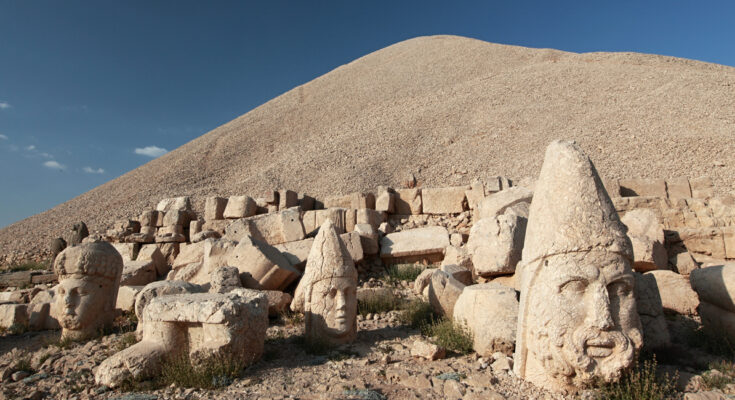Its name comes from the legendary King Nimrod, grandson of the Cham and great-grandson of Noah, who according to the Bible ruled in Mesopotamia after the Flood: Nemrut Dağı, or Mount Nimrod, which rises more than 2,000 meters above the province of Adıyaman, in southern Türkiye, hides an extraordinary archaeological site.
As we approach this mountain of Anti-Taurus, we will see the giant heads carved in rock appearing, at the top of the huge tumulus 150 meters in diameter and 50 meters high that crowns it: the lion, the eagle, the goddess Commagene, Zeus-Oromasdes, Apollo-Mithra-Helios-Hermes, Heracles-Artagnes-Arès, and above all Antiochus Iuh of Commagene, to whom this extensive funerary monument is dedicated.
These heads, more than two meters high, with contours softened over the centuries, are the remains of a site dating from the I century.uh
century BC, built to immortalize the name and features of the ruler, surrounded by protective deities.
More than 2,000 years ago, the small kingdom of Commagene, a buffer zone between the Roman Republic and the Parthian Empire, experienced a brief period of prosperity, while Greek, Persian, Assyrian and Armenian traditions mixed together, as we find in the burial inscriptions of the archaeological site, which was inscribed on UNESCO’s world heritage list in 1987.
The golden age of a vanished kingdom
As impressive as they are, the remains today are far from reflecting the scale of the statues displayed at the time: decapitated and broken, the statues on the western terrace, partly carved into mountain rock, originally formed an ensemble more than nine meters high, framed by large bas-reliefs depicting ancestors and members of the royal family.
After the death of Antiochus Iuhthe kingdom of Commagene declined under his successors and was eventually annexed by the Roman Empire. The shrine was abandoned and shaken by several earthquakes and numerous acts of vandalism, before being rediscovered and rehabilitated in the late 19th century, under the leadership of German engineer Karl Sester.
If at that time there were three processional routes that allowed access to the royal mound, located on three large terraces (north, east and west), now it is possible to get there, on foot or by car, from the Kahta district, in Adıyaman, to reach the entrance of Mount Nemrut National Park.
On the way, we will pass the Karakuş tumulus, which pays tribute to the women of the Commagene royal family and provides an insight into the daily and ceremonial life of the kingdom, before crossing the Septimius Severus bridge, a masterpiece of Roman engineering spanning the bay of Chabinas.
Other archaeological sites, such as the ruins of Arsemia, an ancient royal sanctuary, but also the Kahta castle, which overlooks the farming village of the same name, mark the way to the millennium mountain.



